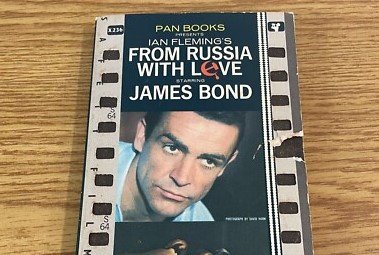The original novels dig deeper — darker, rawer, and more ruthless than anything Hollywood dared to show
James Bond on the big screen is pure swagger: tuxedos, martinis, and death-defying stunts that look like a dream. But the Bond in the books? That guy’s a nightmare wrapped in good tailoring. Ian Fleming’s original 007 wasn’t built to be loved — he was built to get the job done, no matter the mess. For movie fans used to Daniel Craig’s icy control or Roger Moore’s smirks, the novels might feel like a punch to the gut. But if you’re curious enough to peek behind the cinematic curtain, here are the five Bond books that will blow your expectations sky-high — or drag them underground.
The Brutal Elegance of Casino Royale
This is where it all started — not with gadgets, girls, or exploding pens, but a high-stakes game of baccarat and a psychological unraveling.
Fleming’s Casino Royale, published in 1953, is lean, mean, and unflinchingly cold. Forget everything you saw in the 2006 film reboot, because while the spirit is there, the book cuts sharper.
It opens with this zinger: “The scent and smoke and sweat of a casino are nauseating at three in the morning.” Bond isn’t saving the world here — he’s trying to bankrupt a Soviet agent at a card table. And losing could mean death.
Vesper Lynd, the double-agent love interest, isn’t just a tragic twist. She’s Bond’s emotional soft spot — and her betrayal leaves a wound that never really heals. In fact, Fleming revisits her memory in future novels, which tells you something. The movies might move on from their Bond girls; the books don’t always.
One sentence. That’s all it takes to feel the difference here.
This isn’t spy fantasy. It’s espionage with blood under its fingernails.

Moonraker Is Nothing Like the Movie — And That’s a Good Thing
If you think Moonraker is a space-age joke with Roger Moore floating in zero gravity, the book might give you whiplash. And maybe a grim grin.
Written in 1955, it’s arguably the most entertaining Bond novel Fleming ever wrote — and it’s completely unrecognizable from the film adaptation.
Hugo Drax isn’t a space cowboy; he’s a shady industrialist with a mysterious past and an obsession with rockets. And he’s planning something far more chilling than launching lasers into orbit. Fleming pulls off a tense, briskly paced story with Cold War overtones and a surprisingly timely theme: what happens when immense power rests in the hands of one extremely untrustworthy man?
There are no gadgets. No intergalactic nonsense. Just a cunning villain, a looming threat, and Bond trying to outthink a monster in a gentleman’s suit.
From Russia With Love Nearly Killed 007 — Literally
This one almost wrapped the whole series for good. Fleming seriously considered offing Bond at the end of this 1957 installment.
“From Russia with Love” is a masterpiece in set-up and dread. Fleming spends the first third of the novel not with Bond, but with his would-be assassins — setting the stage for an inevitable collision. Rosa Klebb and Red Grant (who’s written like a proto-serial killer) make a terrifying tag team, and Fleming pulls no punches.
In the book, Bond’s famous train fight from the movie doesn’t happen, but somehow the tension is worse. By the time Bond realizes what’s coming, it might be too late. And that ending? Let’s just say the poisoned blade wasn’t just for show.
Interestingly, this was one of President Kennedy’s favorite books. He even named it in a Life magazine interview — boosting Fleming’s global credibility overnight.
One paragraph here reads like a death sentence.
And that’s because it was meant to be.
Dr. No Turns the Volume Up — Way Up
Now we’re getting weird. If you’re the kind of fan who loves Bond movies for the outrageous plots and exotic locales, Dr. No is your jam. But don’t think for a second that Fleming pulls back on the horror.
Bond is nearly killed by a poisonous centipede while asleep. He battles a “dragon” that’s really a flamethrower-equipped vehicle. He’s tortured, starved, and made to crawl through a nightmarish obstacle course. Oh, and there’s a giant squid. Yes. That happens.
What makes Dr. No work is how serious Fleming plays it all. There’s no wink to the camera, no safety net. Even the film dialed it down — partly because Connery wouldn’t go near a spider, let alone a squid.
By the way, the villain’s plan? Sabotaging American missile tests from a secret Caribbean island. Topical? You bet.
Here’s a quick comparison of events:
| Element | Novel | Movie |
|---|---|---|
| Creepy crawler | Centipede in Bond’s bed | Tarantula on a glass plate |
| Villain’s death | Buried under bird guano | Boiled alive in reactor pool |
| Island’s menace | Giant squid, obstacle course | Radioactive facility, vague threats |
The movie paved the way for spectacle. The book dared you to keep turning pages.
Thunderball Sets the Stage for Something Bigger
This one’s kind of a sleeper hit. Thunderball itself is a solid thriller, but it’s more important for what it kickstarts: the “Blofeld Trilogy.”
Published in 1961, Thunderball introduces SPECTRE — a shadowy organization run by the now-iconic Ernst Stavro Blofeld. Instead of leaning on tired Cold War rivalries, Fleming went rogue, crafting an international terror group not aligned with any nation.
It was a creative pivot that gave the series room to breathe — and breathe fire.
The stakes in Thunderball are nuclear. SPECTRE steals warheads and threatens to blow up a major city unless paid handsomely. Bond’s race to stop them is urgent and sweaty, and while the book doesn’t quite hit the emotional highs of what follows, it opens a crucial door.
One paragraph and it’s all in motion.
If you want to read the next two books in the trilogy — On Her Majesty’s Secret Service and You Only Live Twice — Thunderball is your must-read starting point.
And yes, On Her Majesty’s Secret Service might be the greatest Bond story ever told. But that’s a different list.








